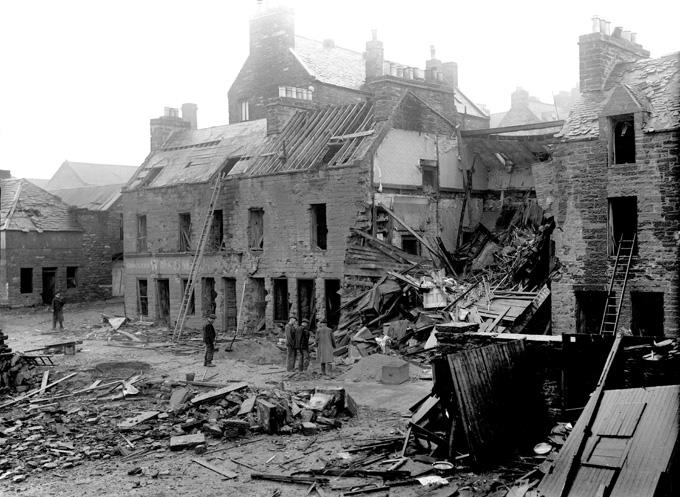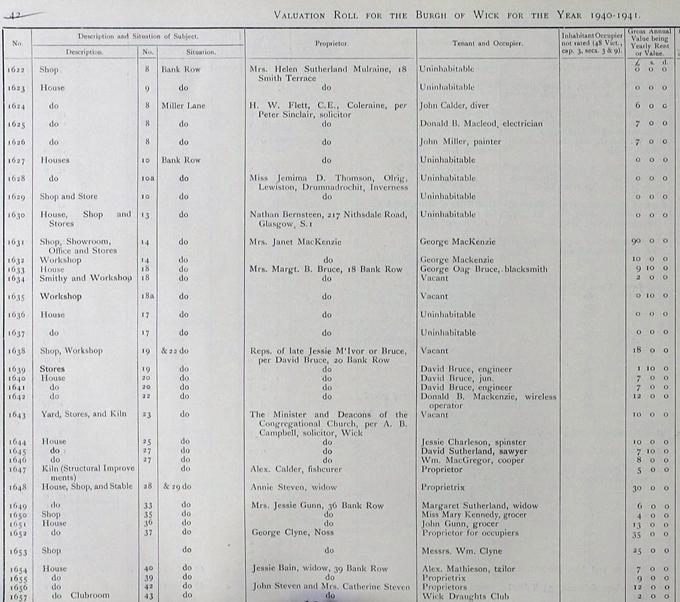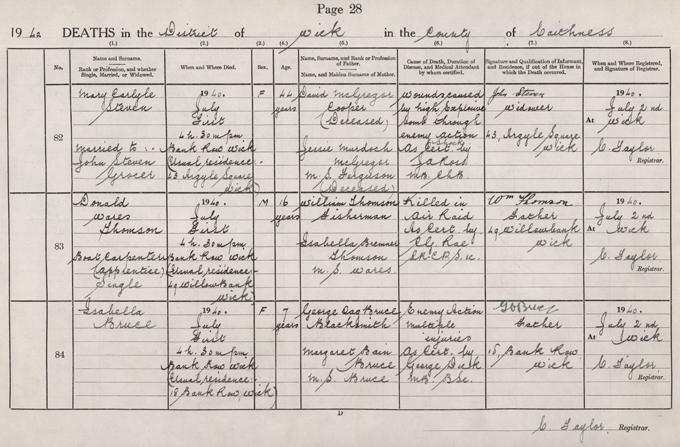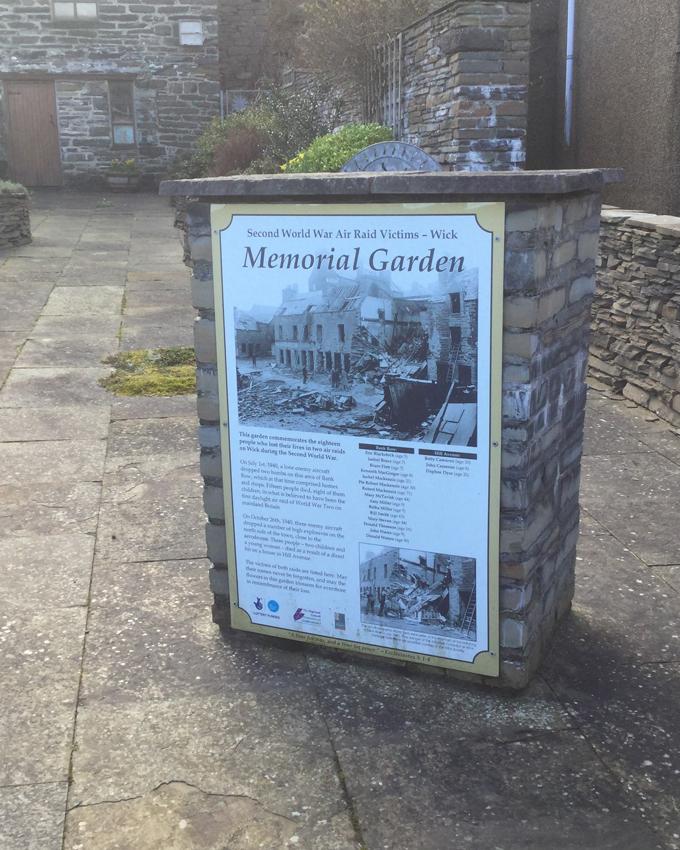National Records of Scotland have published valuation rolls from 1940 on our online research service, ScotlandsPeople, adding over 60,000 new digital images.
The 1940 valuation rolls include more than 2.8 million indexed names and addresses for owners, tenants and occupiers of buildings throughout Scotland, including a record of the annual valued rent. This was the year that the Battle of Britain commenced. In the early days of the war, German aircraft and submarines had launched attacks on ports in Scotland, including Rosyth at the Firth of Forth and Scapa Flow in the Orkney Islands in October 1939. Störangriffe ('nuisance raids') - small probing attacks which took place during night and day - had begun by June 1940. Whilst causing damage to naval property, few homes or civilians were directly affected at this time. On 1 July 1940, however, two bombs fell from enemy planes onto the town of Wick. The valuation rolls record the damage done to properties after buildings were destroyed or left ‘uninhabitable’ and reflect the empty spaces left in the street of Bank Row.
Before the blitz hit London in September 1940, the population of northern Scotland had found themselves amongst enemy action. On the evening of 10 April 1940, 60 German bombers aimed an intensive raid on Scapa Flow, but ultimately failed in their mission, losing seven planes. The people of Caithness were startled by the raid, and alarms were sounded in Wick and Thurso as shellfire lit up the skies. Over time, sightings of enemy planes and dog fights over the sea became more common, ships were lost and war became a reality for the local population.
A few months later, at around 4pm on 1 July, an enemy plane flew over Wick and dropped two bombs. Flying low, the pilot had probably intended to aim for the harbour area, but the bombs fell short of their target and exploded next to each other, directly on the roadway of Bank Row. There had been no warning siren sounded - children on their school holidays were playing in the street in the warm summer’s afternoon whilst adults were shopping or at work – all were caught off guard with devastating consequences.
Image

The scene at Bank Row on 2 July 1940, the day after the bombing
Credit: Wick Society Johnston Collection
Credit: Wick Society Johnston Collection
Amongst the shops on Bank Row were: two tailors, an ironmonger, a butcher, three grocers, one furniture store, one baker, a confectionery shop and a goods and clothes shop. There were also kilns for smoking herring, a cartwrights workshop, and a blacksmiths.
Image

Details from a page of the 1940 Valuation Roll recording houses and shops with their proprietors and tenants in Bank Row after the bombing raid.
National Records of Scotland, 1940 Valuation Roll, VR94/49/246.
National Records of Scotland, 1940 Valuation Roll, VR94/49/246.
Four shops and four dwellings were destroyed completely, with property in nearby Rose street also suffering badly. Other properties, whilst still standing, were left uninhabitable.
Despite a quick response from Wick’s civil defence services, 15 people had died including five men and three women. Seven children were also amongst the dead : Frederick Blackstock (5), Isabella Bruce (7), James Flett (7), Kenneth MacGregor (8) sisters Elizabeth Miller (5) and Amelia Miller (9) Donald Thomson (16) and John Wares (5).
11 of the 15 had died immediately, followed by another four in hospital. Three people were seriously injured, 12 more were slightly injured and several others had sustained minor cuts and bruises.
Image

A page recording the deaths of some of the inhabitants of Wick who died in the bombing on 1 July 1940.
National Records of Scotland, Statutory Register of Deaths, 1940, 043/87 page 28
National Records of Scotland, Statutory Register of Deaths, 1940, 043/87 page 28
Image

A memorial Garden to the bombing now stands in Wick
Credit: National Records of Scotland
Credit: National Records of Scotland
Wick became the focus of enemy attacks in the far north of Scotland and was attacked 6 times over the course of the war. In October 1940, for example, some 140 homes were damaged and three people died when enemy planes dropped bombs and ‘raked the streets with machine gun fire.’ In total, 222 high explosives are said to have been dropped in the north. This formed part of wider air operations across Scotland – with 250 in total by 2 September 1945. During these attacks, 6,400 high explosive bombs and 300 parachute mines fell onto the country.
In a bid to counter these attacks, airfields were established across the country. During the first few months of the ‘phony war’ the north was a major focus of attacks of enemy air raids. Orkney, for example, was where the first civilian of World War Two was killed. James Isbister was hit by a shower of shrapnel in Stenness on March 16th 1940.
Prior to the outbreak of war, there were very few active military airfields in Scotland. As the war progressed, and Caithness provided defences for Scapa Flow in Orkney, the Germans turned their focus to the north of the mainland.
RAF Wick opened in September 1939. Originally a grass field one nautical mile north of the town, it was used for scheduled flights between Inverness, Wick and Kirkwall by 'Highland Airways Limited' before being taken over by the Air Ministry.
Hard runways were made with hangars and other buildings – two of the original hangars and original control tower still stand today. Its location made it an ideal site for Coastal Command Maritime patrols over the North Sea and Atlantic Ocean as pilots flew on reconnaissance, convoy escort and anti-submarine patrols. It was one of the most bombed airfields of World War Two. Airfields were also established at Castletown, Skitten and Dounreay with decoy airfields constructed some distance from the real sites, as well as an emergency landing ground.
The valuation rolls record this significant growth in ‘ministry’ occupancy of property and land, and this is evident when comparing the 1935 and 1940 rolls.
Image

Details from valuation roll entry for Wick Royal Air Force Station recording a yearly rental cost of £4000
National Records of Scotland, Valuation Roll, 1940, VR94/49/20
National Records of Scotland, Valuation Roll, 1940, VR94/49/20
Learn more about the valuation rolls, how to search them and understand their content


